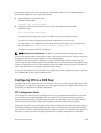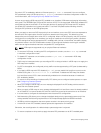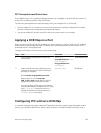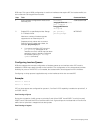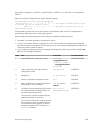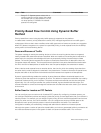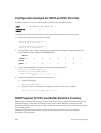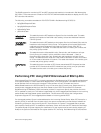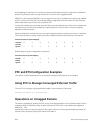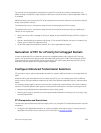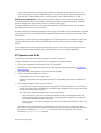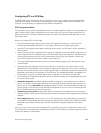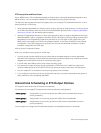The SNMP support for monitoring PFC and BST counters and statistics is introduced in Dell Networking
OS 9.3(0.1). The enhancement is made on F10-FPSTATS MIB with additional tables to display the PFC and
BST counters and statistics.
The following new tables are added in F10-FPSTATS MIB in Dell Networking OS 9.3(0.1):
• fpEgrQBuffSnapshotTable
• fpIngPgBuffSnapshotTable
• fpStatsPerPgTable
• pfcPerPrioTable
fpEgrQBuffSna
pshotTable
This table fetches the BST statistics at Egress Port for the buffer used. This table
displays the Snapshot of the Buffer cells used by Unicast and Multicast Data and
Control Queues.
fpIngPgBuffSna
pshotTable
This table fetches the BST statistics at the Ingress Port for the Shared Cells, and the
Headroom cells used per Priority Group. The snapshot of the Ingress Shared cells
used and the Ingress Headroom cells used per Priority Group, when PFC is
enabled, display in this table. This table lists the
stack-unit index, port number and
the priority group number.
fpStatsPerPgTa
ble
This table fetches the Allocated Min cells, Shared cells, and Headroom cells per
Priority Group, the mode in which the buffer cells are allocated — Static or
Dynamic and the Used Min Cells, Shared cells and Headroom cells per Priority
Group. The table fetches a value of 0 if the mode of allocation is Static and a value
of 1 if the mode of allocation is Dynamic. This table lists the
stack-unit number, port
number and priority group number.
pfcPerPrioTabl
e
This table fetches the number of PFC frames transmitted (PFC Requests) and the
number of PFC frames received (PFC Indications) per priority on a per port basis.
This table lists the stack-unit index, port number and priority.
Performing PFC Using DSCP Bits Instead of 802.1p Bits
Priority based Flow Control (PFC) is currently supported on Dell Networking OS for tagged packets based
on the packet Dot1p. In certain data center deployments, VLAN configuration is avoided on the servers
and all packets from the servers are untagged. These packets will carry IP header and can be
differentiated based on the DSCP fields they carry on the server facing switch ports. Requirement is to
classify these untagged packets from the server based on their DSCP and provide PFC treatment.
Dell Networking OS Releases 9.3(0.0) and earlier provide CLI support to specify the priorities for which
PFC is enabled on each port. This feature is applicable only for the tagged packets based on the incoming
packet Dot1p and Dot1p based queue classification. This document will discuss the configurations
required to support PFC for untagged packets based on incoming packet DSCP.
For the tagged packets, Queue is selected based on the incoming Packet Dot1p. When PFC frames for a
specific priority is received from the peer switch, the queue corresponding to that Dot1p is halted from
scheduling on that port, thus honoring the PFC from the peer. If a queue is congested due to packets
with a specific Dot1p and PFC is enabled for that Dot1p, switch will transit out PFC frames for that Dot1p.
The packet Dot1p to Queue mapping for classification on the ingress must be same as the mapping of
Dot1p to the Queue to be halted on the egress used for PFC honoring. Dell Networking OS ensures that
Data Center Bridging (DCB)
263



